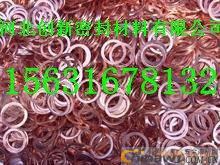Mechanical Seal Repair
A mechanical seal is a critical sealing component that consists of two mating elements — a stationary ring and a rotating ring — positioned perpendicular to the shaft. These rings are designed to maintain a tight, flat contact surface while rotating relative to each other. The sealing medium applies pressure on the contact surface, ensuring that the two faces remain tightly sealed. A thin liquid film forms between them, providing both hydrodynamic and static pressure, which helps in lubrication and maintaining balance. This mechanism ensures effective sealing and reduces wear over time.
1. Cleaning and Inspection of Mechanical Seals
Before assembling a mechanical seal, it's essential to thoroughly clean all components such as the rotating ring, stationary ring, and bushing. Any impurities can lead to premature failure or leakage.
Inspect the surfaces of both the static and dynamic rings for scratches, cracks, or other imperfections that could compromise the seal. If available, use specialized tools to check for flatness. A non-flat surface may cause the seal to fail after installation due to uneven pressure distribution. In some cases, a hydraulic test before assembly can help identify potential issues.
Check the seat of the dynamic ring and the static ring for any defects that might affect the seal. Ensure that the sealing ring is intact and free from damage.
Examine the compensation spring for deformation, corrosion, or changes in its resistance coefficient. A faulty spring can significantly impact the performance of the seal.
Inspect the seal bushing for burrs, grooves, or other irregularities that might interfere with proper operation.
Clean and inspect all rubber seals for cracks, bubbles, or wear. Measure the diameter to ensure it falls within the acceptable tolerance range.
For mechanical seals used in pumping systems, check the screw pump’s spiral for cracks or broken wires that could affect performance.
2. Dimensional Checks During Assembly
Measure the sealing surface of the static and dynamic rings to confirm their radial width. When using different friction materials, the hard material should have a slightly larger radial width (about 1–3 mm) than the soft one to prevent edge embedding.
Check the clearance between the static and dynamic rings and the shaft or bushing. The static ring should typically be 1–2 mm larger in inner diameter than the shaft, while the dynamic ring needs to be 0.5–1 mm larger to allow for floating and compensate for shaft vibration. However, excessive clearance can cause misalignment and reduce seal effectiveness.
Assess the end face specific pressure, which is crucial for proper sealing. Too much pressure can cause overheating and accelerated wear, while too little can lead to leakage. This pressure is usually determined during design, but it can be measured during assembly by comparing distances from the gland to the static and dynamic ring end faces.
Check the length of the compensation spring. Over time, springs may shorten or deform due to centrifugal force, affecting the seal’s performance.
Measure the anti-rotation pin length and the depth of the pin hole to avoid misalignment or damage during assembly.
3. Grinding the End Faces
After removing the rotating ring, begin with rough grinding using abrasives ranging from 80 to 160 grit, then proceed with fine grinding using 160+ grit. For cemented carbide or ceramic rings, polishing with a machine using boron carbide (M28 to M5) is recommended to achieve a mirror finish. Ceramic rings can be polished with chrome oxide after fine grinding with M5 agate powder.
Graphite-filled PTFE static rings, being softer, can be refined using kerosene or gasoline without abrasive. Their self-lubricating properties allow for less stringent finishing requirements.
Use either a grinding machine or a manual figure-eight method on a flat glass surface for grinding.
4. Bushing Inspection
Inspect the bushing for rust or wear. Minor issues can be addressed with fine sandpaper, while severe damage may require electroplating or replacement.
5. Seal Rings
Most seal rings lose elasticity or degrade over time, so they should generally be replaced with new ones.
6. Springs
If the spring shows no signs of rust, it may still be usable. However, if it is severely corroded or has lost significant elasticity, a new spring should be installed.
For mechanical seals with assembled boxes, clean the box and inspect for worn or deformed grooves. Repairs, re-grooving, or replacement may be necessary.
After repair, reassemble the seal and conduct a pressure test before putting it into normal operation. (Source: Sealed Net)
**Packing Series**: Carbon packing, PTFE packing, graphite packing, high-water-based packing, aramid-PTFE mixed packing, aramid-carbon mixed packing, PTFE-cut wire packing, PTFE packing, expanded PTFE packing, aramid packing, asbestos packing, carbon fiber packing, butter packing, oil-impregnated asbestos packing, asbestos-rubber packing, glass fiber packing, ceramic fiber packing, nylon packing, composite fiber packing, ceramic packing, and more.
**Gasket Series**: PTFE gasket, PTFE-coated gasket, flexible graphite gasket, metal-coated gasket, asbestos-rubber mat, graphite composite gasket, toothed gasket, asbestos gasket, ladle gasket, metal spiral gasket, graphite gasket, high-strength graphite gasket, PTFE gasket, rubber flange gasket, asbestos manhole gasket, asbestos hand hole gasket, autoclave special sealing ring, reactor kettle special sealing ring, etc.
**Rubber Products**: Silicone, fluorine rubber, nitrile rubber, EPDM, neoprene, and other custom-shaped rubber products.
**PTFE Products Series**: PTFE rod, PTFE raw material belt, PTFE elastic belt, PTFE gasket, PTFE sheet, and more.
**Graphite Products**: Graphite packing, graphite rope, graphite gasket, high-strength graphite composite mat, flexible graphite packing ring, and other custom graphite components.
Hebei Innovation Sealing Material Co., Ltd.
Mobile: [Phone Number]
Phone: [Phone Number]
Website: [Website URL]
Contact: Business Manager

JINING SHANTE SONGZHENG CONSTRUCTION MACHINERY CO.LTD , https://www.stszcmparts.com